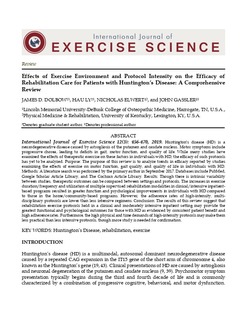| dc.contributor.author | Dolbow, James D. | |
| dc.contributor.author | Ly, Hau | |
| dc.contributor.author | Elwert, Nicholas | |
| dc.contributor.author | Gassler, John | |
| dc.date.accessioned | 2019-06-26T09:57:56Z | |
| dc.date.available | 2019-06-26T09:57:56Z | |
| dc.date.issued | 2019 | |
| dc.identifier.citation | Dolbow, James D.; Ly, Hau; Elwert, Nicholas; and Gassler, John (2019) "Effects of Exercise Environment and Protocol Intensity on the Efficacy of Rehabilitation Care for Patients with Huntington’s Disease: A Comprehensive Review," International Journal of Exercise Science: Vol. 12 : Iss. 3, Pages 456 - 470. https://digitalcommons.wku.edu/ijes/vol12/iss3/6 | nb_NO |
| dc.identifier.uri | http://hdl.handle.net/11250/2602272 | |
| dc.description.abstract | Huntington’s disease (HD) is a neurodegenerative disease caused by astrogliosis of the putamen and caudate nucleus. Motor symptoms include progressive chorea, leading to deficits in gait, motor function, and quality of life. While many studies have examined the effects of therapeutic exercise on these factors in individuals with HD, the efficacy of such protocols has yet to be analyzed. Purpose: The purpose of this review is to analyze trends in efficacy reported by studies examining the effects of exercise on motor function, gait quality, and quality of life in individuals with HD. Methods: A literature search was performed by the primary author in September 2017. Databases include PubMed, Google Scholar Article Library, and The Cochran Article Library. Results: Though there is intrinsic variability between studies, therapeutic outcomes can be compared between settings and protocols. The increases in exercise duration/frequency and utilization of multiple supervised rehabilitation modalities in clinical/intensive inpatient-based programs resulted in greater function and psychological improvements in individuals with HD compared to those in the home/community-based programs. However, the adherence rates of high-intensity, multi-disciplinary protocols are lower than less intensive regimens. Conclusion: The results of this review suggest that rehabilitation exercise protocols held in a clinical and moderately intensive inpatient setting may provide the greatest functional and psychological outcomes for those with HD as evidenced by consistent patient benefit and high adherence rates. Furthermore, the high physical and time demands of high-intensity protocols may make them less practical than less intensive protocols, though more study is needed for confirmation. | nb_NO |
| dc.publisher | International Journal of Exercise Science | nb_NO |
| dc.rights | Attribution-NoDerivatives 4.0 Internasjonal | * |
| dc.rights.uri | http://creativecommons.org/licenses/by-nd/4.0/deed.no | * |
| dc.subject | Huntington’s Disease | nb_NO |
| dc.subject | rehabilitation | nb_NO |
| dc.subject | exercise | nb_NO |
| dc.title | Effects of Exercise Environment and Protocol Intensity on the Efficacy of Rehabilitation Care for Patients with Huntington’s Disease: A Comprehensive Review | nb_NO |
| dc.type | Journal article | nb_NO |
| dc.source.pagenumber | 456-470 | nb_NO |
| dc.source.volume | 12 | nb_NO |
| dc.source.journal | International Journal of Exercise Science | nb_NO |
| dc.source.issue | 3 | nb_NO |

